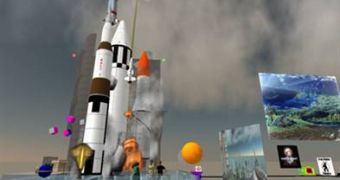The synthetic world known as Second Life is more than a game, it has things that are not of this world, including floating launch pads, mini-planets, space shuttles and an international space station. More is on the way: environments that look and feel like the moon, for instance, or simulated lava tubes that could help researchers build real-life bases on the moon or Mars.
Science fiction is a huge draw in Second Life, an online environment where more than 5 million user-controlled characters, or "avatars," can interact with each other. There are virtual enclaves for fans of "Star Trek", "Battlestar Galactica", "Serenity" and other outer-space realms from films and TV shows. But what we're talking about here is a different level of virtual space, drawing upon real spacecraft and real-life organizations.
Since colonization of real outer space worlds is still far in the future, and the only real space adventure available to amateur astronauts is a small trip at the edge of space, costing around $20 million, the more "accessible" virtual version is the next best thing, if you can get there.
You can stroll (or fly) through the International Spaceflight Museum, where 52 virtual rockets from 12 countries are on display, including a mammoth Saturn 5, a fully loaded space shuttle and the SpaceShipOne rocket plane.
If you know the right people, you can even launch your own model rockets, or ride skyward on the tip of a ballistic missile. "What's really fun is when you can go out and build your own rocket," said Robin Snelson (a.k.a. Rocket Sellers), who gave a presentation on Second Life rocketry at last week's Space Access '07 conference.
From the museum's grounds, you can fly (or teleport) straight up to what passes for low Earth orbit, where a shuttle can be seen closing in to dock with the space station. From there, you can teleport to floating displays of the planets, a solar system lineup that still includes Pluto. In virtual miles, the Pluto display isn't nearly as far from Earth's surface as the real thing (3 billion miles), but it's still quite a fall if you jump off the edge.
It will be up to you to discover if there is such a thing as virtual vertigo as you fell to Earth from Pluto.

 14 DAY TRIAL //
14 DAY TRIAL //